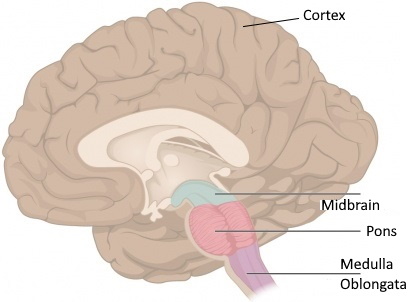The brainstem is located at the base of the brain and at the top of the spinal cord.
It is composed of 3 sections in descending order: the midbrain, the pons and the medulla oblongata.
It is responsible for many vital life functions, such as breathing, consciousness, blood pressure, heart rate, and sleep.
It contains white matter and gray matter.
Structure of the brainstem
The brainstem is generally considered to be made up of three parts, from top to bottom:
- Midbrain
- Pons (part of the metencephalon)
- medulla oblongata
Anatomy
The brainstem is located in the posterior part of the skull.
Connexions
- Above, the midbrain is continuous with the cerebral hemisphere.
- Below, the medulla is continuous with the spinal cord.
- Posteriorly, the pons and medulla are separated from the cerebellum by the fourth ventricle.
Blood supply
- The brainstem receives blood from the vertebrae and the basilar artery.
- The bulb is supplied with blood via the medial and lateral perforating arteries.
- The pons and midbrain receive blood via the medial and lateral perforating arteries.
Brain stem functions
The brainstem has three major functions:
1. It serves as a “conduit” for the ascending and descending tracts connecting the spinal cord to the various parts of the higher centers of the forebrain.
2. It contains important reflex centers associated with the control of:
- breathing;
- of the cardiovascular system, e.g. blood pressure
- autonomic functions such as digestion, salivation, sweating, pupil dilation or contraction, urination, etc.
3. It contains cranial nerve nuclei III to XII.
Clinical signs related to brain stem damage
These are conditions can affect the brainstem, such as cerebrovascular accidents (CVA), malignant tumors and demyelinating processes.
Multiple sclerosis is characterized by visual disturbances, including blurred double vision, which is a common early symptom of sclerosis.
A stroke can cause serious symptoms, including:
- Breathing problems, frequently leading to death.
- Difficulty chewing, swallowing and speaking.
- Weakness or paralysis of the arms, legs and/or face.
- Problems with balance or sensation.
- Hearing loss.
- Vision problems.
- Vertigo.
- Coma.
- Hemiballismus caused by damage to the subthalamic nucleus.
- Damage or degeneration of dopaminergic neurons in the substantia nigra resulting in Parkinson’s disease.
- Wallenberg stroke (spinothalamic tract, trigeminal spinal tract, hypothalamospinal tract, vestibular nuclei).
- Cerebellar herniation (sudden respiratory and cardiac arrest due to cord compression).
- Medial pontine syndrome (abducens nerve, corticospinal tract).
- Pontine central myelinolysis which can lead to seizures, ataxia and impaired consciousness.

